Files in this item
Spin–lattice and electron–phonon coupling in 3d/5d hybrid Sr3NiIrO6
Item metadata
| dc.contributor.author | O’Neal, Kenneth R. | |
| dc.contributor.author | Paul, Arpita | |
| dc.contributor.author | al-Wahish, Amal | |
| dc.contributor.author | Hughey, Kendall D. | |
| dc.contributor.author | Blockmon, Avery L. | |
| dc.contributor.author | Luo, Xuan | |
| dc.contributor.author | Cheong, Sang-Wook | |
| dc.contributor.author | Zapf, Vivien S. | |
| dc.contributor.author | Topping, Craig V. | |
| dc.contributor.author | Singleton, John | |
| dc.contributor.author | Ozerov, Mykhalo | |
| dc.contributor.author | Birol, Turan | |
| dc.contributor.author | Musfeldt, Janice L. | |
| dc.date.accessioned | 2019-08-27T12:30:03Z | |
| dc.date.available | 2019-08-27T12:30:03Z | |
| dc.date.issued | 2019-08-21 | |
| dc.identifier | 260876541 | |
| dc.identifier | 81ce9561-a48c-414c-bf7e-a68e43836e0a | |
| dc.identifier | 85070949351 | |
| dc.identifier | 000493558000002 | |
| dc.identifier.citation | O’Neal , K R , Paul , A , al-Wahish , A , Hughey , K D , Blockmon , A L , Luo , X , Cheong , S-W , Zapf , V S , Topping , C V , Singleton , J , Ozerov , M , Birol , T & Musfeldt , J L 2019 , ' Spin–lattice and electron–phonon coupling in 3 d /5 d hybrid Sr 3 NiIrO 6 ' , npj Quantum Materials , vol. 4 , 48 . https://doi.org/10.1038/s41535-019-0184-x | en |
| dc.identifier.issn | 2397-4648 | |
| dc.identifier.other | RIS: urn:8D6E18065B968AE8823435984335ABB7 | |
| dc.identifier.other | RIS: O’Neal2019 | |
| dc.identifier.uri | https://hdl.handle.net/10023/18380 | |
| dc.description | Research at the University of Tennessee, Rutgers University, and University of Minnesota is supported by the National Science Foundation DMREF program (DMR-1629079, DMR-1629059, and DMR-1629260, respectively). The crystal growth was partially supported by the National Research Foundation of Korea (NRF) funded by the Ministry of Science and ICT (No. 2016K1A4A4A01922028). We also appreciate funding from the U.S. Department of Energy, Basic Energy Sciences, contract DE-FG02-01ER45885 (Tennessee), “Science at 100 Tesla” (LANL), and “Topological phases of quantum matter and decoherence” (LANL). The NHMFL facility is supported by the U.S. National Science Foundation through Cooperative Grant DMR-1644779, the State of Florida, and the U.S. Department of Energy. | en |
| dc.description.abstract | While 3d-containing materials display strong electron correlations, narrow band widths, and robust magnetism, 5d systems are recognized for strong spin–orbit coupling, increased hybridization, and more diffuse orbitals. Combining these properties leads to novel behavior. Sr3NiIrO6, for example, displays complex magnetism and ultra-high coercive fields—up to an incredible 55 T. Here, we combine infrared and optical spectroscopies with high-field magnetization and first-principles calculations to explore the fundamental excitations of the lattice and related coupling processes including spin–lattice and electron–phonon mechanisms. Magneto-infrared spectroscopy reveals spin–lattice coupling of three phonons that modulate the Ir environment to reduce the energy required to modify the spin arrangement. While these modes primarily affect exchange within the chains, analysis also uncovers important inter-chain motion. This provides a mechanism by which inter-chain interactions can occur in the developing model for ultra-high coercivity. At the same time, analysis of the on-site Ir4+ excitations reveals vibronic coupling and extremely large crystal field parameters that lead to a t2g-derived low-spin state for Ir. These findings highlight the spin–charge–lattice entanglement in Sr3NiIrO6 and suggest that similar interactions may take place in other 3d/5d hybrids. | |
| dc.format.extent | 6 | |
| dc.format.extent | 1162329 | |
| dc.language.iso | eng | |
| dc.relation.ispartof | npj Quantum Materials | en |
| dc.subject | QC Physics | en |
| dc.subject | NDAS | en |
| dc.subject.lcc | QC | en |
| dc.title | Spin–lattice and electron–phonon coupling in 3d/5d hybrid Sr3NiIrO6 | en |
| dc.type | Journal article | en |
| dc.contributor.institution | University of St Andrews. School of Physics and Astronomy | en |
| dc.identifier.doi | 10.1038/s41535-019-0184-x | |
| dc.description.status | Peer reviewed | en |
This item appears in the following Collection(s)
Items in the St Andrews Research Repository are protected by copyright, with all rights reserved, unless otherwise indicated.

